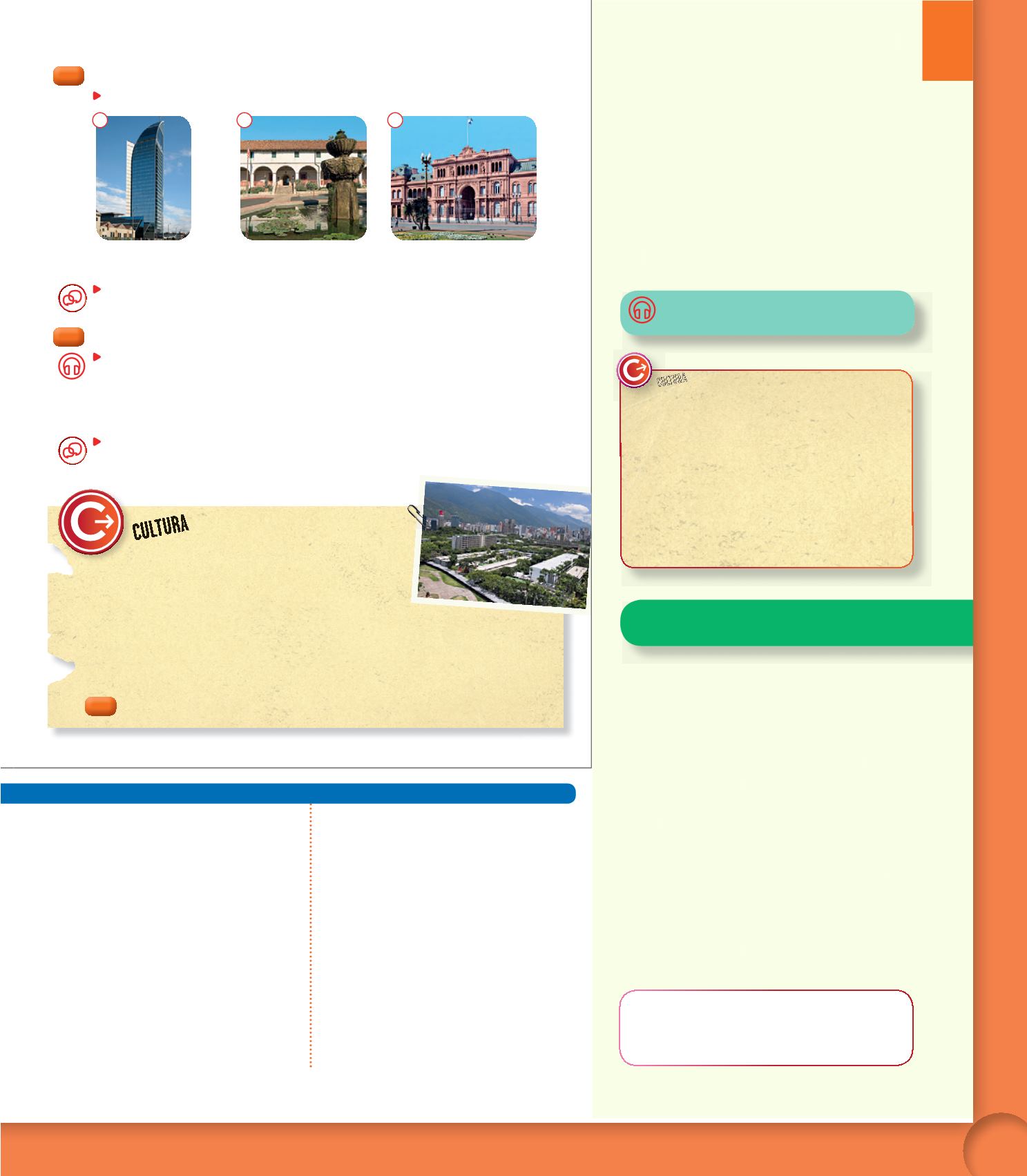

87
38.
After listening, project or show photos of the
sculptures described in the conversation and
ask students to match each image with the
description heard. Have students chat with a
partner to describe which of the sculptures
they like best.
AUDIO SCRIPT
See page 297L.
Answer Key
36.
Answers will vary. Sample answers:
1. piedra, cemento, concreto, cristal, granito
2. catedral, mezquita, templo, sinagoga,
rascacielos, palacio, acueducto, puente
3. arco, columna, torre, ventana
4. esculpir, representar, construir, crear
37.
Answers will vary.
▶
Answers will vary.
38.
1. Guerreros olmecas. Son de basalto.
2. Los moáis de la isla de Pascua. Son de
piedra volcánica.
3. Se llama
Mujer y pájaro
. Es de cemento.
4. Son muy grandes y representan figuras
humanas.
▶
Answers will vary.
39.
Answers will vary.
Vocabulario – Arquitectura
y escultura
DESAFÍO 2
Unit
6
HERITAGE LANGUAGE LEARNERS
r
Ask students to research some architectural
landmarks in their heritage country. Explain
that they may consider not only public
buildings, but also bridges, parks, private
residences, and structures such as
stadiums, towers,
glorietas
(roundabouts),
and fountains. Have students bring in
images of these landmarks and be prepared
to give some background information on the
piece, including its history, architect,
materials used, date of construction, and
any other anecdotal information. Ask
students to share this information with the
rest of the class.
CRITICAL THINKING
r
Ask students to imagine that their
community wants to commission a sculpture,
but has not decided who or what it should
represent and where the art will be
exhibited. Have students write a proposal to
the local government, proposing a sculpture,
where it should be located and why, the
material(s) that would be used to make it,
the style of the piece, the approximate
dimensions of the finished art, and any other
information that might help sway the
community in their favor. Students might also
assign their art a name.
3
7
¿Cómo es?
Escribe
una descripción de cada uno de estos edificios. ¿Cuál te gusta más? ¿Por qué?
Habla
con tu compañero(a). Comparen estos edificios con los de su comunidad.
Después, presenten sus conclusiones a la clase.
3
8
Exploremos la escultura
Escucha
y responde a estas preguntas.
1.
¿Qué representaban las esculturas que vio Michelle en México? ¿De qué material son?
2.
¿Qué famosas esculturas describe Ethan? ¿De qué material están hechas?
3.
¿Cómo se llama la escultura que describe Eva? ¿De qué material es?
4.
¿Qué tienen en común las tres esculturas que describen los personajes?
Habla
con tu compañero(a) sobre la escultura más impresionante que conoces.
Después, escribe un párrafo comparándola con la que ha descrito tu compañero(a).
La Ciudad Universitaria de Caracas
Conocida como la «Ciudad museo», la Ciudad Universitaria de
Caracas, del famoso arquitecto venezolano Carlos Raúl
Villanueva, se considera una obra maestra de la arquitectura
moderna y fue declarada Patrimonio de la Humanidad por la UNESCO en el año 2000.
En este espacio el arquitecto logró combinar de forma magistral las edificaciones y la
naturaleza, es decir, el arte como parte del espacio. Además del conjunto de edificios,
la Ciudad Universitaria de Caracas cuenta con más de cien obras de artistas de todo
el mundo, como Alexander Calder y Jean Arp.
9
3
Piensa.
¿Te gusta la arquitectura moderna o prefieres los edif ci ios ant gi uos? ¿Por qué?
Casa Rosada.
Buenos Aires (Argentina).
3
Torre de las Comunicaciones.
Montevideo (Uruguay).
1
Misión de Santa Bárbara.
California (Estados Unidos).
2
Additional Resources
Fans Online activities
Practice Workbook
La Ciudad Universitaria de Caracas
Carlos Raúl Villanueva began work on this
new campus in 1945. Villanueva’s vision was
to integrate the new architectural forms and
contemporary art of the 20th century with
university buildings. One of the most notable
buildings is the Aula Magna, which contains a
sculpture by Alexander Calder—a prominent
American sculptor.
L
U TURA
C
319
Book 4 Unit 6


















